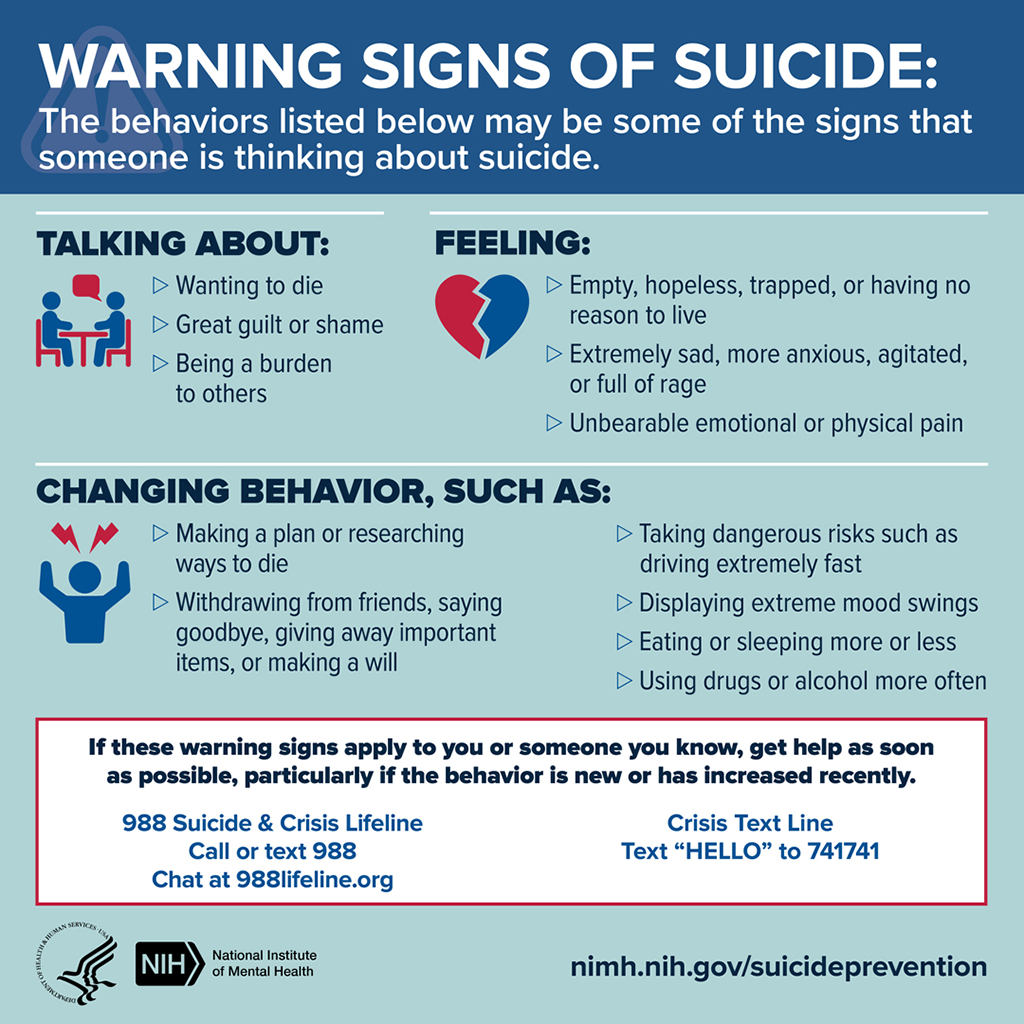Trigger Warning (TW): If any reader is currently struggling with suicidal thoughts, they should seek immediate professional help. Call or text The Suicide & Crisis Lifeline at 988. If you are in immediate danger or experiencing an emergency, call 911. This article is not intended to be a replacement for professional medical advice or assistance.
The arena is often filled with roaring cheers, the pressure to achieve, and the thrill of competition. But off the field, many athletes grapple silently with mental health challenges. With unique pressures and vulnerabilities, it’s pivotal to recognize and address the signs and provide essential support in suicide prevention.
While September is widely recognized as Suicide Prevention Month, it’s critical that we educate ourselves and are aware of a very serious issue that is becoming more prevalent all year long.
The Realities & Statistics
The global landscape of mental health is concerning. The World Health Organization (WHO) lists several key suicide statistics:
- More than 700,000 people succumb to suicide every year.
- Suicide is the fourth leading cause of death among 15–29-year-olds.
- Many suicides happen impulsively in moments of crisis with a breakdown in the ability to deal with life stresses, such as financial problems, relationship break-ups, or chronic pain and illness.
- Additional risk factors for suicide include mental disorders; previous suicide attempts; experiencing conflict, disaster, violence, abuse, or loss, and a sense of isolation; as well as within vulnerable groups who experience discrimination.
In the United States, The Centers for Disease Control and Prevention (CDC) lists the following facts about suicide:
- Suicide rates increased approximately 36% between 2000–2021.
- Suicide was responsible for 48,183 deaths in 2021, which is about one death every 11 minutes.
- In 2021, an estimated 12.3 million American adults seriously thought about suicide, 3.5 million planned a suicide attempt, and 1.7 million attempted suicide.
- In 2021, suicide was among the top 9 leading causes of death for people ages 10-64. Suicide was the second leading cause of death for people ages 10-14 and 20-34.
- The suicide rate among males in 2021 was approximately four times higher than the rate among females. Males make up 50% of the population but nearly 80% of suicides.
Teen and Young Adult Suicide Statistics:
- According to the National Alliance on Mental Illness, suicide is a major crisis in teens and young adults. It notes that “11% of young adults (ages 18-25) report that they’ve had serious thoughts about suicide, and about 1–2% report a suicide attempt during the prior year. These numbers are higher among high school students — nearly 20% report serious thoughts about suicide and 9% report a suicide attempt. Among young adults 15–24 years old in the U.S., the rate of death by suicide in 2019 was about 14 per 100,000 people — slightly higher than one suicide for every 10,000 people in this age group.”
- The same NAMI report also notes, “There is a large gap between the number of young people thinking about suicide (about 1 in 10) and the number who die by suicide (1 in 10,000). In other words, there are 1,000 young people currently struggling with the idea of ending their life for each young person lost to suicide. Most importantly, that means that there are 1,000 opportunities to provide understanding and support to those experiencing difficulties.”
Zooming in on the athletic community, we know that athletes are not immune to mental health struggles. While comprehensive statistics specific to athletes might be sparse, the emotional battles resulting from pressures to perform, fear of failure, and injuries are very real.
Athlete Suicide Statistics:
- Suicide is the third-leading cause of death among student-athletes ages 15 to 24. (source)
- In 2022, five NCAA student-athletes died by suicide within a two-month span. The total number for the year was unavailable at the time that this article was written.
- Traumatic Brain Injury (TBI) may be associated with a higher risk of suicide. One TBI study found that “in 34 529 deaths by suicide over 35 years, individuals with medical contact for traumatic brain injury, compared with the general population without traumatic brain injury, had an increased risk of suicide, incident rate ratio of 1.90.” Another study from 2020 that looked at the association between suicide risk and TBI found that “The overall risk of suicide attempts was 2.23 times higher in the TBI group compared with the non-TBI group (0.98 vs 0.29 per 1000 person-years, respectively) after adjustment for covariates.”
- Adding to this, a CNN article reported that, “Females may be more susceptible to concussion, and they also have worse and prolonged symptoms after their injury than men, according to a review of 25 studies of sport-related concussion published in the Orthopaedic Journal of Sports Medicine.”
- Note: There is little recent research available specific to athlete suicide rates. Independent reports from families seem to be the most currently available information in regard to the number of athletes who died by suicide, but at the time of this article, there was not a recent formal study available to cite.
2024 College Student Athlete Suicide Statistics
In 2024, a report by the British Journal of Sports Medicine found that collegiate student-athlete suicides have doubled over the last 20 years.
“Among US college athletes, suicide is now the second leading cause of death after accidents — and rates have doubled from 7.6% to 15.3% over the past 20 years, according to a study published April 4 in the British Journal of Sports Medicine.” (Source: CNN)
The study also found that:
- Division I and II athletes had a higher suicide incidence rate than Division III athletes.
- No significant differences in suicide incidence rates by sex, race, or sport were identified.
The Role of Impulsiveness in Suicide
Alarmingly, suicide is not always something that is planned for far in advance. In a study of suicide attempt survivors, many said they made the choice within less than five minutes of thinking about it. (Simon 2005).
- 24% said less than 5 minutes
- 24% said 5-19 minutes
- 23% said 20 minutes to 1 hour
- 16% said 2-8 hours
- 13% said 1 or more days
Recognizing the Warning Signs
Understanding and recognizing potential warning signs can be a life-saving intervention:

- Verbal cues: Statements like “I can’t go on,” “I have nothing to live for,” or “I want out” can be glaring red flags. You may also hear them talk about feeling trapped or like they no longer recognize themselves, are in unbearable pain, or feel like a burden. However, do not rely on verbal clues alone as some individuals will internalize their thoughts and pain.
- Behavioral cues: A significant deviation from routine behavior, retreating from favorite activities, or social isolation might signal distress. Do not assume someone just wants more alone time than usual, or they are just being a “teenager” or any other assumption. If there is a change in their normal behavior, have a discussion with them. You may also notice them writing, drawing, or talking about death.
- Emotional cues: Watch out for heightened irritability, bouts of hopelessness, sudden mood transitions, or increasing anxiety. Extreme mood swings are also another sign.
For athletes, added layers of stress from performance expectations or physical injuries can exacerbate these signs.
How to Offer Support
Support isn’t always about solving someone’s problems but about showing you’re there:
- Open the dialogue: Create a safe space for conversation. Just listening can make a significant impact. Ask open-ended questions (i.e., not ‘yes’ or ‘no’ questions.) Also, let the person know that you don’t have to offer advice or solutions, you can just listen. In addition, keep asking because the person may not open up at first; a safe space is a consistent space.
- Avoid dismissing their feelings: It’s vital to approach their feelings with empathy and understanding. Validate what they are saying. Listen without judgment.
- Encourage professional help: Gently suggest seeking therapy or counseling. You may also want to offer to help the person to find the right support and take them to the appointment. Mental illness can feel very isolating and scary so helping the person get to the right resource can be a huge difference maker.
- Stay connected: A simple message, call, or meetup can be a beacon of hope. Check-in regularly. Offer to spend time with them doing an activity they you both enjoy and may make it easier for them to open up to you.
What to Say if You Are Struggling
If you are struggling, take the step to ask for help. It may be the hardest and most courageous thing you’ll ever do for yourself, but never give up. Always choose life.
If you’re having trouble finding the right words, here are some phrases to consider:
- This isn’t easy for me to say, but I need help and you are someone that I trust. I am struggling with some inner stuff and I’m not sure where to start. Do you have some time to speak with me?
- Hey, I’m not feeling okay lately and need someone to talk to.
- I am not feeling like myself lately. Can we talk today?
Major Key: Keep asking until you get help. Don’t ever give up on yourself! You matter!
There are always solutions. Even if you can’t see it in the moment, there are always options, and it is 100% possible to regain your happiness, freedom, and inner peace. Give yourself that chance.
Resources and Helplines
Turn to trusted family, friends, mentors, coaches, religious leaders, or anyone whom you feel safe with.
For immediate assistance, you can also contact The Suicide & Crisis Lifeline: Call or Text 988
*This article was originally published in 2023 and later updated with new data.

